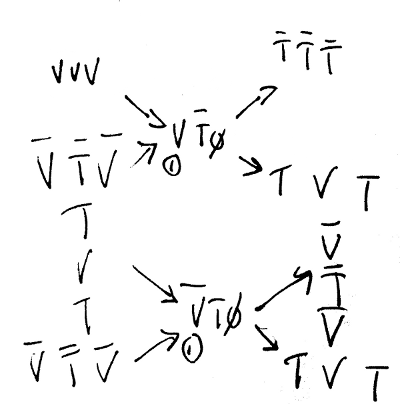Next: B Meson Oscillation Up: Decay Patterns as Phase Previous: Decay Patterns as Phase Contents
Particle phase transitions in the Rishon Model are quite detailed, making a first example quite awkward to choose. Primarily this is down to the VT0 transitions needing to occur in pairs. Starting with what is termed a "decay pattern" of the neutron into a proton, anti-neutrino and an electron, we have:
 figureNeutron phase-transition to proton
figureNeutron phase-transition to proton
|
At the top left of the diagram, a neutrino-anti-neutrino pair are brought
into existence (explained later). The down quark and the neutrino
undergo a
![]() T0 phase transition into an up quark and an electron.
At the same time the remaining two neutron quarks undergo an opposite
phase transition V
T0 phase transition into an up quark and an electron.
At the same time the remaining two neutron quarks undergo an opposite
phase transition V
![]() 0, but,
unusually, transform back into the exact same two particles they originally
were (u and down quarks) - just in different places. This allows the positions
of the two particles to change places in the I-Frame with minimal disruption to
the structure, and, importantly, ensuring that the I-Frame's rules are also
respected.
0, but,
unusually, transform back into the exact same two particles they originally
were (u and down quarks) - just in different places. This allows the positions
of the two particles to change places in the I-Frame with minimal disruption to
the structure, and, importantly, ensuring that the I-Frame's rules are also
respected.
So, the two VT0 phase transforms, being direct opposites and representing the exchange each of one T and one V particle with an anti-T and an anti-V particle, effectively cancel each other out. No energy is lost or gained in the process. The concept of "decay" is therefore considered, under this model, to be rather strange and archaic (which leaves the only place where decay actually occurs as being when a particle meets an anti-particle and annihilate to create a photon in the form of gamma radiation).
After the phase transforms occur, it is worthwhile adding up the total number of T-anti-T and V-anti-V particles to ensure that they are the same: we find that the total of each of the two charges is the same both before and after, thanks to the paired VT0 phase transforms preserving the totals of each charge.
It is worthwhile noting that whilst these phase transition (pairs of) are the simplest that could be found, they mathematically represent in effect the total phase transition that occurred. Other such phase transitions may in fact exist which more accurately represent what actually occurs.
lkcl 2016-12-29